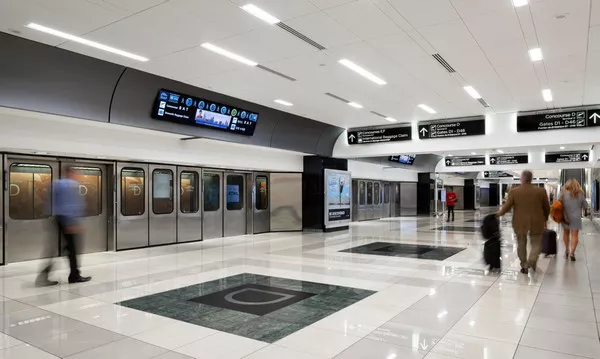As hubs of connectivity and bustling gateways to the world, airports play a pivotal role in shaping global travel patterns. In the United States, a country known for its vast expanse and diverse regions, several airports stand out as major aviation hubs. This article takes an in-depth look at the ten biggest airports in the U.S., exploring their size, facilities, and the crucial role they play in facilitating domestic and international air travel.
10 Biggest Airports in the United States
1. Hartsfield-Jackson Atlanta International Airport (ATL): The Busiest Hub in the World
Topping the list is Hartsfield-Jackson Atlanta International Airport, a behemoth in the world of aviation. As the busiest airport globally in terms of passenger traffic, ATL serves as a crucial connecting point for travelers from across the globe. Boasting an extensive network of domestic and international flights, this Atlanta-based airport plays a pivotal role in the U.S. aviation landscape.
2. Los Angeles International Airport (LAX): The Gateway to the Pacific Rim
Nestled in the heart of Southern California, Los Angeles International Airport stands as the second-largest airport in the U.S. Known for its iconic Theme Building and diverse terminals, LAX serves as a major gateway to the Pacific Rim. Its strategic location and state-of-the-art facilities contribute to its significance as a key player in global aviation.
3. Chicago O’Hare International Airport (ORD): A Hub of Innovation
Situated in the heart of the Midwest, Chicago O’Hare International Airport is a bustling hub renowned for its innovation and efficiency. As one of the busiest airports in the world, ORD connects travelers to various destinations worldwide. With its cutting-edge technology and commitment to sustainability, O’Hare remains a key player in shaping the future of air travel.
4. Dallas/Fort Worth International Airport (DFW): A Texas-Sized Hub
In the heart of the Lone Star State, Dallas/Fort Worth International Airport stands as a testament to Texan grandeur. Recognized for its vast size and comprehensive facilities, DFW serves as a major hub for both domestic and international flights. Its central location in the U.S. makes it a key player in connecting passengers across the country and beyond.
5. Denver International Airport (DEN): Where the Rockies Meet the Skies
Nestled against the stunning backdrop of the Rocky Mountains, Denver International Airport is an architectural marvel and a critical hub in the U.S. aviation network. Renowned for its expansive runways and distinctive architecture, DEN is a key player in facilitating travel to and from the western United States.
6. John F. Kennedy International Airport (JFK): The Gateway to the Big Apple
As the primary airport serving the New York City metropolitan area, John F. Kennedy International Airport holds a special place in the world of aviation. Situated in Queens, JFK is a crucial gateway for international travelers, connecting the Big Apple to destinations around the globe. Its diverse terminals and extensive facilities contribute to its prominence on the global aviation stage.
7. San Francisco International Airport (SFO): Bridging Continents in the Bay Area
Perched on the shores of the San Francisco Bay, San Francisco International Airport serves as a major gateway between the United States and the Asia-Pacific region. Recognized for its commitment to sustainability and technological innovation, SFO plays a vital role in connecting passengers and cargo across continents.
8. Seattle-Tacoma International Airport (SEA): A Gateway to the Pacific Northwest
In the vibrant Pacific Northwest, Seattle-Tacoma International Airport stands as a key player in connecting the region to the rest of the world. With its modern facilities and commitment to passenger experience, SEA contributes to the economic vitality of the Pacific Northwest and serves as a vital hub for both domestic and international travel.
9. McCarran International Airport (LAS): Where the Desert Meets the Strip
Located in the heart of the vibrant city of Las Vegas, McCarran International Airport is a bustling hub known for its proximity to the famous Las Vegas Strip. As a major gateway for leisure travelers and business professionals alike, LAS plays a crucial role in connecting the entertainment capital of the world to destinations far and wide.
10. Orlando International Airport (MCO): The Magic of Central Florida
Nestled in the heart of Central Florida, Orlando International Airport serves as a key player in connecting travelers to the enchanting world of theme parks and attractions. As a major hub for tourism, MCO plays a vital role in facilitating travel to and from the Sunshine State, contributing to the economic vibrancy of the region.
See Also: World’s Top 10 Countries For Biodiversity
Conclusion:
As we traverse the skies and explore the vast expanse of the United States, these ten airports stand as pillars of connectivity, innovation, and efficiency. From the bustling hubs of Atlanta and Los Angeles to the strategic gateways of Dallas/Fort Worth and Denver, each airport plays a unique role in shaping the landscape of air travel. As the aviation industry continues to evolve, these airports will remain at the forefront, connecting people and cultures in the spirit of global connectivity.
You Might Be Interested In:
























